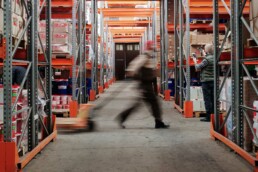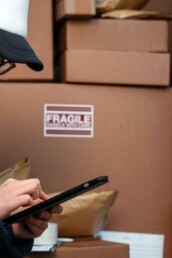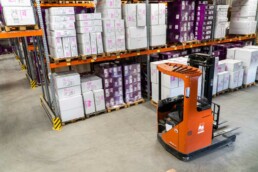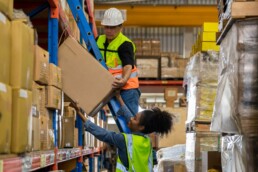Leveraging Fulfillment Companies in Navigating E-commerce
Unleashing Fulfillment Companies’ Expertise For E-commerce Success
Leveraging Fulfillment Companies when Navigating E-commerce Hurdles
The digital revolution of e-commerce has propelled companies onto online platforms and digital marketplaces, ushering in a new era of possibilities. Nevertheless, despite the undeniable benefits, many distributors encounter hurdles when navigating the e-commerce terrain. Therefore, this blog delves into the challenges at hand and underscores the pivotal role fulfillment companies play in surmounting these obstacles.

The E-commerce Revolution: A Paradigm Shift in Distribution
E-commerce has triggered a seismic shift in the distribution sector. Consequently, with the advent of digital platforms, businesses now have the ability to extend their reach across the globe while streamlining their supply chains. This convenience-driven transformation empowers both buyers and sellers, ushering in a new era of commerce.
Research reinforces this paradigm shift, revealing that a staggering 94% of B2B decision makers consider the current omni-channel landscape to be as effective or even more effective than pre-COVID times. In effect, large distributors have eagerly embraced this digital tide, reaping the rewards. However, for smaller regional players, the relationship with e-commerce can be intricate.
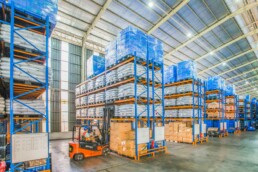
Overcoming E-commerce Challenges with Fulfillment Expertise
One issue many businesses face is the limited visibility into customer browsing behavior. While distributors can observe website traffic, they often lack detailed insights into product preferences and the motivations behind customer interactions.
Enter fulfillment companies – we help to unravel the mysteries of online business. By partnering with fulfillment providers like us, distributors gain a granular understanding of their customers’ behavior, enabling them to refine their strategies and tailor offerings effectively.
Furthermore, e-commerce initiatives demand substantial investments of time, money, and technological resources. However, the shortage of these essential elements often hampers the success of an e-commerce venture. That’s where we come in. Armed with your warehousing to provide distribution expertise, we step in to bridge the gap. Our proficiency in inventory management, pick and pack services, and shipping and delivery solutions ensures that distributors can concentrate on growth without being bogged down by logistical complications.

Leveraging Fulfillment for Building Relationships
Trust is cultivated through personal relationships. However, embracing e-commerce necessitates a paradigm shift, demanding the establishment of digital trust. This transition can be seamless with the aid of fulfillment companies.
Fulfillment relationships, in particular, enable distributors to leverage the capabilities of e-commerce while nurturing trust-based relationships. By synchronizing e-commerce analytics tools, distributors can measure performance, optimize customer journeys, and deliver exceptional experiences.
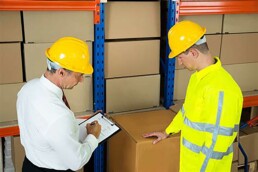
Embracing the Fulfillment Revolution
Distributors stand at a crossroads, where embracing e-commerce isn’t just an option – it’s a survival imperative. Above all, long gone are the days of only holding a brick and mortar operation. Fulfillment companies offer a strategic compass, guiding distributors to maximize their existing e-commerce investments. Given that, the fusion of data-driven insights and fulfillment prowess signals a revolution in customer engagement.
This transformation isn’t confined to the virtual realm; it extends to the physical world through last-mile delivery, cross-docking, and supply chain optimization. Fulfillment ensure that every facet of the e-commerce experience is seamlessly, enabling distributors to scale their operations while ensuring on-time delivery and order accuracy, which is at 99.5% currently for us here at Falcon.
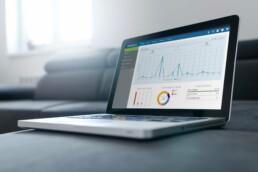
The Fulfillment Advantage Moving Into the Future
The intricate relationship between e-commerce and fulfillment is achieved through cutting-edge technologies like cloud-based warehouse management systems (WMS), to track your inventory 24/7. It is important to realize the power of order tracking software, to monitor packages and ensure your communication with your customer is accurate.
As distributors embrace e-commerce integration services, fulfillment experts guide the orchestration of outbound shipments, employing packaging optimization, freight consolidation, and even value-added services (VAS) to elevate the customer experience.
Beginner’s Guide to Third-Party Logistics (3PL)
The world of e-commerce is always changing, understanding the roll of Third-Party Logistics is integral to keeping up. This beginner’s guide to third-party logistics (3PL) will delve into the essential aspects, offering insights into fulfillment services, warehousing, and much more.
Read More…
Unleash Your E-commerce Potential with Fulfillment Solutions
As the distribution sector marches toward an e-commerce-centric future, fulfillment companies emerge as invaluable allies when navigating e-commerce. Fulfillment companies that help in navigating e-commerce can benefit you with their expertise of the supply chain, from inventory management to multi-channel fulfillment, these partners empower distributors to navigate the digital labyrinth.
Want to see what Falcon Fulfillment can do for you?
Let’s Talk!
Discover the Telltale Signs for Outsourcing Fulfillment
Is Your Business Ready to Soar?
Discover the Telltale Signs for Outsourcing Fulfillment
Welcome to the Falcon Fulfillment Blog, where we empower D2C e-commerce brands with the insights they need to optimize their fulfillment operations. As your business gains momentum and your customer base expands, you may find yourself facing critical decisions about your logistics strategy. Are you unsure whether it’s time to transition from in-house fulfillment to a more efficient and scalable solution? In this comprehensive article, we’ll explore the telltale signs for outsourcing fulfillment and key indicators that will help you identify if your business is ready to take flight with outsourced fulfillment.

Balancing Volume and Communication
As an ambitious and growing brand, you’re no stranger to managing high-volume order processing. But have you noticed that as your business expands, personalized communication with your customers is becoming more challenging? This consistent pain point can affect customer satisfaction levels, potentially impacting your long-term success.
Recommendation
Discover Falcon Fulfillment, a 3PL company that strikes the perfect balance. With the capacity to handle substantial volume and the luxury of direct communication, Falcon Fulfillment offers efficient and personalized account management. Custom kitting and branded packaging options are just a few ways they add that extra touch to your customer’s unboxing experience.

Balancing In-house Investment with Strategic Partnerships
In-house fulfillment requires substantial investment in infrastructure, technology, and personnel. For well-established companies, this can be a viable route, but for startups and expanding brands, allocating capital wisely becomes a critical decision.
Recommendation
Look for telltale signs outsourcing fulfillment might be the right move for your business. Consider what’s most crucial for your growth and success. By partnering with Falcon Fulfillment, you can focus on your core strengths while leveraging their fulfillment expertise and established infrastructure. This strategic partnership frees up resources, allowing you to invest in other essential areas of your brand’s development.

Tailored Solutions for Unique Needs
Every e-commerce business is distinct, with unique requirements for fulfillment. Are you seeking a 3PL partner capable of providing customizable solutions to meet your specific demands?
Recommendation
At Falcon Fulfillment, flexibility is key. From kitting options to long-term storage solutions, they understand that your business might need tailored services beyond standard DTC fulfillment. Carefully assess your needs and align them with a 3PL that checks all the boxes.
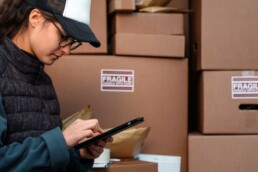
Calculating Costs vs. ROI
Investing in infrastructure, technology, and skilled staff for in-house fulfillment can strain your budget and resources.
Recommendation
Consider the opportunity cost of managing your own fulfillment operations versus partnering with Falcon Fulfillment. Outsourcing can be a game-changer, as it allows you to focus on core business aspects, leaving logistics to the experts.

Navigating the Decision-making Process:
Choosing the right 3PL partner can make or break your fulfillment experience. Equip yourself with essential questions to ask potential 3PL providers.
Recommendation
We’ll provide you with a comprehensive list of crucial inquiries to ensure you make an informed decision. From the 3PL’s years of experience and references to their ability to accommodate custom setups, these questions will empower you to choose a partner that perfectly aligns with your business goals.
Beginner’s Guide to Third-Party Logistics (3PL)
The world of e-commerce is always changing, therefore understanding the roll of Third-Party Logistics is integral to keeping up. In light of this our beginner’s guide to third-party logistics (3PL) will delve into the essential aspects, offering insights into fulfillment services, warehousing, and much more.
Read More…
When it comes to fulfillment, timing is everything. Recognizing the signs that indicate your readiness to outsource can be a transformative moment for your e-commerce venture. With Falcon Fulfillment’s remarkable 99.9% order accuracy and impressive 96.7% 2-day shipping record, you have a reliable partner poised to elevate your business to new heights.
Are you ready to unleash the full potential of your e-commerce business? Take the leap and discover why Falcon Fulfillment is the trusted ally for D2C e-commerce owners and retailers seeking enhanced communication, efficiency, and growth.
Ready to step up your fulfillment game?
Let’s Talk!
Essential Strategies for the Peak E-commerce Season
Essential Strategies for Excelling During Peak E-commerce Season
As the peak e-commerce season from November to January swiftly approaches, businesses must initiate their preparations now. Particularly in light of ‘Christmas in July,’ serving as a reminder to plan ahead, we’ll provide guidance on essential strategies for this peak e-commerce season, aiming to optimize logistics and operations. Undoubtedly, to ensure a seamless and successful peak season, it’s vital to incorporate the following supply chain and fulfillment solutions, such as Third-Party Logistics (3PL), e-commerce fulfillment, shipping and delivery, inventory management, and more.
1. Address Peak Season Timing
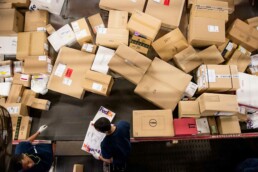
To gain a competitive edge during peak seasons, it’s advantageous to start early with 3PL providers to secure fulfillment services and warehousing well in advance. This proactive approach enables businesses to anticipate and manage demand spikes effectively, providing a strategic advantage.
2. Create Data-Driven Demand Forecasts

To optimize your inventory management for peak seasons, leverage 3PL partners equipped with advanced inventory management and order fulfillment solutions. By analyzing past peak season data and quarter-over-quarter sales fluctuations, you can make informed decisions on inventory stocking and preparations.
3. Utilize Distributed Inventory
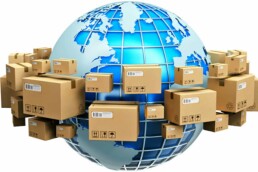
By partnering with a 3PL that offers multi-site distribution centers for efficient warehousing and order fulfillment, you can implement essential strategies for peak e-commerce. This approach provides faster shipping options and helps reduce shipping costs, ultimately resulting in increased conversions and heightened customer satisfaction.
4. Streamline Internal Communications

During peak seasons, when securing support from fulfillment teams becomes more challenging, clear, transparent, and consistent communication remains crucial for successful fulfillment. It’s imperative to proactively reach out to suppliers, manufacturers, 3PL partners, and distributors to ensure a seamless experience during high sales periods.
5. Automate Customer Communications

By leveraging your cloud-based Warehouse Management Systems (WMS), effectively utilize order details to provide shipping and tracking information to your customers. This approach not only saves valuable human resources but also enhances customer satisfaction by setting clear expectations.
6. Prepare for Returns
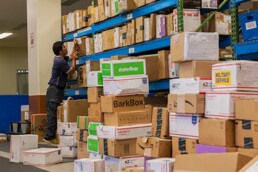
To ensure a streamlined returns process, first establish a seamless system with your 3PL partner. Next, make use of Return Merchandise Authorization (RMA) processing alongside your Warehouse Management System (WMS) to efficiently handle returns. Consequently, this will allow you to promptly update inventory levels, thereby minimizing disruptions to your supply chain.
7. Plan to Launch Big Sales Early

To preempt the surge in demand during the peak season, initiate significant sales promotions early. This strategic approach places spikes in sales outside the general public timeframe, effectively reducing the chance for missed deliveries due to higher loads handled by small package carriers. Additionally, promote your 3PL partners’ same-day and seven-day shipping options to encourage early shopping and distribute order influxes evenly. Lastly, ensure an open line of communication capable of handling these sudden spikes in demand.
8. Manage Your Inventory and Planning by September

Based on your forecasting, begin to work with suppliers and manufacturers on projected sales during peak season because this is a critical essential strategy for peak e-commerce. Consequently this helps to mitigate stockouts, backorders, and losing customers. Overall the more information you can provide to your partners, the more likely you will have a triumphant peak. In addition, pre-order stock where possible and negotiate with warehousing suppliers.
Beginner’s Guide to Third-Party Logistics (3PL)
The world of e-commerce is always changing, therefore understanding the roll of Third-Party Logistics is integral to keeping up. In light of this our beginner’s guide to third-party logistics (3PL) will delve into the essential aspects, offering insights into fulfillment services, warehousing, and much more.
Read More…
Implementing Essential Strategies for Peak E-commerce is Critical
To excel during the peak e-commerce season, businesses must strategically prepare their logistics and operations. In essence, leveraging the expertise of 3PL providers to offer e-commerce fulfillment, inventory management, and multi-channel fulfillment solutions is crucial. Additionally, employing automation for customer communications and returns processing, while optimizing packaging and freight rates for cost-effective shipping, is paramount. By implementing these essential strategies for peak e-commerce, you can effectively set your business up for success and deliver an exceptional shopping experience to your customers.
Get Ready For Your Peak Season! Have questions?
Let’s Talk!
How to Create an Effective Reverse Logistics Plan
How to Create an Effective Reverse Logistics Plan
Any successful streamlined supply chain relies heavily on reverse logistics. Consumers have grown to expect an easy return policies and processes. Creating an effective reverse logistics plan can increase sales, customer satisfaction, and loyalty. Let’s look at what reverse logistics is and how to create an effective plan.

What is reverse logistics?
Reverse logistics is a type of supply chain management that moves goods from customers back to businesses responsible for selling or creating them. Simply put, reverse logistics deliver goods from the customer back to the manufacturer or seller. Returns are the most common; however, reverse logistics can include refurbishing, unsold seasonal goods, delivery failure, and repairs or maintenance.
How does reverse logistics work?
The reverse logistics process begins after the sale of a product. Typically, a customer or vendor initiates it when they are dissatisfied with a product or no longer find it useful. The steps required for a return to be successful will vary greatly by industry. Depending on the industry and product, the responsible party will arrange for the transportation of the item back through the supply chain. This includes sending return labels, packing materials if necessary, or scheduling a local pickup for larger or bulky items.
Why create a reverse logistics plan?
A reverse logistics plan can reduce storage and distribution costs. It can improve customer relationships, retention, and satisfaction and create a sustainable supply chain. Some companies are starting to leverage their return policies as a competitive advantage. Let’s get into the components and best practices of an effective reverse logistics plan.
Components of creating an effective reverse logistics plan.
Returns Management
Returns management is the area of business operations that oversees inbound product returns. An effective plan will leverage methods that ensure speed, visibility, and control. This includes; implementing technology for automated returns, inventory tracking, restocking, and disposing of products ineligible for resale. Building an effective returns process can help a company reduce, reuse, and recycle materials that otherwise would end up in a landfill, thus boosting a company’s sustainability efforts. Not only that, but managing returns will help to increase profitability by minimizing inventory costs.
Return Policy and Procedure
A return policy or procedure are the rules that a retailer outlines when a customer needs to return or exchange a product for any reason. The bare minimum included in a return policy is the type of products that can be returned, acceptable reasons for a return, and the timeframe in which a return needs to be actioned. It is crucial to develop a fair and balanced return policy because this helps build trust between a brand and the consumer. Vital elements of a great returns policy are as follows:
- Clear communication
- Hassle-free
- Costs are fair (e.g., don’t make the customer pay for return shipping if the item arrived damaged)
- Flexible (if a customer is one day over the timeframe, make an exception)
- Quickly refund money when necessary
Refurbishment
Another part of creating an effective reverse logistics plan could involve refurbishing products. Depending on industry-specific compliance, many returned products can simply be re-added to inventory for resale. However, there are times when a return is salvageable but must be refurbished or remanufactured. When done well, a solid refurbishment process helps a company recoup financial losses from a return. Additionally, refurbished goods help protect the environment from needless waste.
Unsold Goods
What to do with seasonal or unsold merchandise? Consumers expect brands to dispose of their inventory in a socially responsible way. Big brands that are in the habit of simply trashing their unsold goods are beginning to be called out by dumpster diving activists. Consumers expect brands to dispose of their inventory in an environmentally conscious way. There are a few crafty ideas to help eliminate unsold inventory and minimize the environmental impact of returns.
End-of-Life (EOL)
>While a vintage t-shirt may not have an end-of-life cycle, technology certainly does. Many companies prepare thoroughly for the initial life-cycle stages, including introducing new products, upgrading features, upselling accessories, etc. However, few companies adequately prepare for a product to be phased out. Depending on what products your company sells will determine if an EOL procedure should be included in your reverse logistics plan. Here are a few things to consider if your product does have an EOL cycle;
- Develop an in-depth strategy for sunsetting the product
- Monitor component production for parts that are critical for the product (e.g., Tesla’s battery replacement)
- Communicate with customers early and often if a product will no longer be serviced or available
- Develop a plan to dispose of EOL products responsibly

Steps to create an effective reverse logistics plan.
Receive, acknowledge, and process the return.
The first element of reverse logistics is when a customer wants to return a product. Outline a clear way for the customer to begin this process in your returns policy. Once the return has been initiated, it is essential to acknowledge the request has been received. Next is processing the return. Processing a return should include the following:
- return authorization
- scheduling return shipments
- sending package labels if necessary
- receiving returned items
- evaluation of product condition<
- issuing refund
- Shipping an exchange or replacement
Handle returned goods.
Once the returns process begins, it will reach the processing center, where the next step involves categorization. Specifically, the item will undergo options such as being fixed, resold as new, resold as a return, recycled, scrapped, or refurbished. A fully optimized reverse logistics plan will complete categorization before the item arrives at the processing center.
Move returns forward.
Each item, based on its category, requires movement or dispatch to the relevant department. For example, the department responsible for repairs should handle items in need of repair. Similarly, products suitable for resale as new should be reintegrated into the inventory and stored for resale. Often, the returns department can become overcrowded with products waiting for relocation. Managing returns promptly helps businesses prevent inventory level errors and recapture lost revenue.
Repair or refurbish items.
If a returned product is repairable, deliver it to the respective department. For products deemed unsuitable for repair, consider dismantling and selling them for parts. After rebuilding or refurbishing the item, add it to the relevant inventory category.
Recycle
Companies that focus on recycling are doing their part in creating a sustainable future and will be ahead of the curve. Recycle any goods that do not meet the standards for repair, refurbishment, or resale. Locate a recycling partner for products that are unsuitable for resale.
Dispose of unusable products.
Ideally, maintaining a small size for this category relies on carefully following each of the previous steps. Moreover, it remains imperative to execute the disposal of unusable products with consideration for social and environmental impact. Additionally, when other options exhaust, discarding returned products becomes necessary.
Beginner’s Guide to Third-Party Logistics (3PL)
The world of e-commerce is always changing, therefore understanding the roll of Third-Party Logistics is integral to keeping up. In light of this our beginner’s guide to third-party logistics (3PL) will delve into the essential aspects, offering insights into fulfillment services, warehousing, and much more.
Read More…
Every business we have a unique approach to reverse logistics. The product type, industry, and even timeframe will determine which areas of the reverse logistics plan need detailed insights. Regardless, successful companies create effective reverse logistics plans before they attempt to make their first sale. They understand that returns happen, and the more seamless the process, the happier their customers will be. Get in touch today to learn more about how Falcon Fulfillment can help you manage your reverse logistics process.
Contact us to learn more about our services.
Let’s Talk!
An Overview of 3PL Fulfillment and Its Benefits
3PL fulfillment and its benefits for your business.
As a retailer, you know how important it is to provide your customers with a great shopping experience. But, to do that, you need to have a reliable and efficient fulfillment process. This is where 3PL (third-party logistics) fulfillment comes in. This article provides an overview of 3PL fulfillment and its benefits for your business.
What is 3PL Fulfillment?
Third-party logistics (3PL) fulfillment consists of outsourcing many of the supply chain management tasks to an external logistics provider. This includes the storage and distribution of products, as well as providing services like order fulfillment, returns processing, inventory management, freight forwarding, and more. By outsourcing these tasks, companies can reduce costs and increase operational efficiency. 3PL fulfillment also helps to improve customer service, as the logistics provider is responsible for delivering products to customers on time and in good condition.
Why use a 3PL fulfillment partner?
Third-party logistics (3PL) fulfillment services can be an invaluable asset for retailers. By outsourcing their warehousing, inventory management, order processing, and shipping to a 3PL, retailers can save time and money while having access to a more extensive, more efficient distribution network. 3PLs also provide access to sophisticated tracking and reporting tools, allowing retailers to monitor their customers’ orders and inventory levels. Additionally, 3PLs offer scalability and flexibility, accommodating a retailer’s growth as business increases. Ultimately, 3PLs provide retailers with an efficient and cost-effective solution to managing their supply chain, allowing them to focus on their core business and providing excellent customer service.
Core 3PL Fulfillment Benefits for Your Business

Gain expertise and knowledge
Business owners are navigating ever-changing landscapes in the global marketplace. Hiring in-house staff that covers transportation documentation, customs compliance, import/export law, and international launch strategies can be challenging and expensive. Companies that partner with a quality 3PL gain the experience and knowledge of fulfillment experts. Businesses looking to expand into new markets can shorten the cycle by leveraging the insight of a 3PL that already services that region.
Save time and money
Managing your fulfillment operation can be costly. Paying for drivers, trucks, warehouse space, infrastructure, technology, and inventory management becomes time-consuming and expensive. Partnering with a 3PL can save you time in money in the following ways:
- 3PLs negotiate carrier contracts with fair and reasonable rates due to higher order volumes
- 3PLs offer flexible warehousing options, and many offer a pay-as-you-use contract
- 3PLs provide access to robust and modern inventory and order management technology
- 3PL partners hire and manage fulfillment staff (eliminates the expense of HR/insurance/benefits for what tends to be a larger team)
- Many 3PLs offer distributed warehousing, which allows for more affordable shipping rates
Operational flexibility and scalability
One of the greatest benefits of 3PL fulfillment for your business is the flexibility and scalability they provide. Partnering with a 3PL provider allows businesses to scale up or down without investing substantially in overhead. They can provide flexible warehousing/staff throughout the year. This means that when a company has a boom in sales, it can quickly grow to meet the need. Equally important is the flexibility to scale back when unexpected bumps in the road occur.
Improved customer satisfaction
 Working with a solid 3PL partner is one of the best ways to improve customer satisfaction ratings. You will delight more customers than ever by leveraging their expanded network of carriers, advanced tracking technology, and streamlined fulfillment processes. Customers expect to have transparent, real-time tracking details, as well as lightning-fast delivery. These benefits are only achievable with significant investment. Therefore, partnering with a 3PL can also save money by improving customer satisfaction and retention scores.
Working with a solid 3PL partner is one of the best ways to improve customer satisfaction ratings. You will delight more customers than ever by leveraging their expanded network of carriers, advanced tracking technology, and streamlined fulfillment processes. Customers expect to have transparent, real-time tracking details, as well as lightning-fast delivery. These benefits are only achievable with significant investment. Therefore, partnering with a 3PL can also save money by improving customer satisfaction and retention scores.
Beginner’s Guide to Third-Party Logistics (3PL)
The world of e-commerce is always changing, therefore understanding the roll of Third-Party Logistics is integral to keeping up. In light of this our beginner’s guide to third-party logistics (3PL) will delve into the essential aspects, offering insights into fulfillment services, warehousing, and much more.
Read More…
Regardless of who you choose for your 3PL fulfillment needs, they can bridge the gap as your business expands. A quality 3PL fulfillment partner has many benefits including; saving your business time and money as well as improve customer satisfaction. See what the experts at Falcon Fulfillment can do for your business.
Get in touch with one of our friendly agents today.
Let’s Talk!
5 Reasons 3PL Services Are Key to Supply Chain Efficiency
Why 3PL Fulfillment Services Are Key to Supply Chain Efficiency
The productivity of the supply chain relies significantly on how effectively a company can deliver its products to the right location at the right time. Due to the growth of e-commerce, businesses are increasingly relying on third-party logistics (3PL) fulfillment services to ensure the efficient operation of their supply chain. Additionally, 3PL fulfillment services offer various strategies, ranging from inventory storage and management to fulfilling and shipping customer orders. These services can aid in maintaining the smooth operation of your supply chain. But why is their importance significant? Here are five reasons why 3PL fulfillment services play a key role in ensuring supply chain efficiency.
Supply Chain Metrics to Track
To understand why a 3PL is key to supply chain efficiency, we must first examine the metrics used to track success. A few common metrics that determine the health and productivity of a supply chain, and they are as follows:
- Perfect Order Index – Perfect order measures show you the percentage of how many orders are fulfilled successfully and without any incidents, including inaccurate orders, late deliveries, or damaged items.
- Cash-to-Cash Cycle – The cash-to-cash cycle is the time period between when a business pays cash to its suppliers for inventory and receives money from its customers. The simple cash-to-cash calculation formula is:

- Inventory Turnover Ratio – The inventory turnover ratio measures the number of times a company replaced its inventory balance across a specific period.

- Order Accuracy – The percentage of orders accurately taken, sent to production teams, and delivered successfully to the end consumer.
- Supply Chain Cycle Time – Supply chain cycle time is the time it would take to complete a customer’s order if inventory levels were at zero when the order was placed. The shorter the cycle, the more efficient the supply chain is.
Supply chain efficiency is measured in speed, accuracy, and profitability. A 3PL fulfillment service participates in streamlining several aspects of the supply chain, directly affecting its productivity.
5 reasons why 3PL fulfillment services are key to supply chain efficiency.
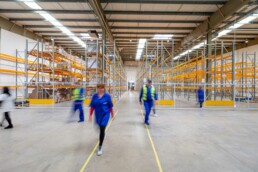
Optimized Inventory Management
One of the primary advantages of utilizing a 3PL is its capability to enhance inventory control. By actively monitoring your stock levels, it enables you to plan future orders more effectively and maintain inventory balance. When you outsource inventory management to a 3PL, you gain access to flexible storage options. Furthermore, it leads to quicker and more cost-effective order fulfillment, advanced inventory management software implementation, and a decreased need for inventory and fulfillment personnel. This not only prevents overstocking and stockouts but also trims costs, exerting a significant positive influence on your business’s efficiency.
Increased Visibility
Having a clear vision of your inventory, from sourcing and producing to warehousing and final delivery, is necessary to improve your supply chain efficiency. Outsourcing your fulfillment will often give you real-time visibility from dock to door, covering a significant portion of the supply chain process. Increased visibility helps your company discover bottlenecks and inefficiencies that slow down cycle times and cost you money.
Automation and Real-time Data
Automating supply chain processes is one of the most effective ways to improve supply chain efficiency and productivity. Implementing automated inventory management systems helps to improve order efficiencies. This reduces stockouts as well as overstocking. Working with a 3PL fulfillment team gives you access to real-time inventory and distribution systems that would require significant investment to own in-house. Furthermore, this allows a whole suite of automation processes to be deployed, such as; invoice processing, order processing, and even returns management. The best 3PL providers will have implementation guidance to ensure that your sales software works hand in glove with theirs.

Route Optimization
Unsurprisingly, selecting the fastest and most affordable route for product delivery is vital to supply chain efficiency. Working with a solid 3PL partner ensures this is handled for you. Fulfillment companies’ success and profitability hinge on the same metrics; therefore, they will prioritize route optimization for every order.
Optimized Returns Management
Returns management or reverse logistics can often be overlooked in supply chain efficiencies, but that is a mistake. With an average of 20% of all online orders ending in a return or exchange, mismanaging returns can negatively impact the bottom line. In fact, one of the main value-added services offered by 3PL companies is returns management. They can help automate the process of receiving, evaluating, and restocking products when they are no longer wanted or required by a customer.
Beginner’s Guide to Third-Party Logistics (3PL)
The world of e-commerce is always changing, therefore understanding the roll of Third-Party Logistics is integral to keeping up. In light of this our beginner’s guide to third-party logistics (3PL) will delve into the essential aspects, offering insights into fulfillment services, warehousing, and much more.
Read More…
These are just a few reasons why 3PL fulfillment services are key to supply chain efficiency. Using a 3PL, can optimize inventory management, increase visibility, automate processes using real-time data, and optimize routes and returns management. In conclusion, if you want to improve supply chain efficiency, a 3PL might be the perfect solution. Falcon Fulfillment specializes in every aspect of supply chain management, from planning and procurement to distribution and returns. We can assist with streamlining your supply chain.
Get in touch with one of our specialists today to find out more.
Let’s Talk!
7 Tips to Make Your E-commerce Business More Sustainable
Make Your E-commerce Business More Sustainable
Making an e-commerce business more sustainable is not only a great way to reduce your environmental footprint but also enhances the shopping experience for your customers. For example, a 2020 consumer survey conducted by McKinsey revealed that 60% of respondents were willing to pay more for brands that utilize sustainable packaging. Moreover, the sustainability trend continues to gain momentum, especially among younger buyers.
According to Insight, nearly 90% of Gen X consumers said they would be willing to spend an extra 10% or more on sustainable products, compared to just over 34% two years ago. Fortunately, you can take plenty of simple steps to make your e-commerce business more sustainable and eco-friendly, accordingly here are 7 tips to make your e-commerce business more sustainable:

1. Choose eco-friendly packaging
To begin with, use eco-friendly packaging materials such as cardboard boxes, recycled paper, and biodegradable packing peanuts. This not only reduces the amount of plastic and other non-recyclable materials used in e-commerce packaging but also promotes sustainability. For instance, here are some of the most popular eco-friendly packaging alternatives:
- Compostable materials – any packaging that will decompose naturally in under 180 days in an at-home composting environment is considered compostable. One of the most popular varieties is compostable mailers.
- Recycled materials – make good use of plastics already in circulation by reusing mailers or selecting products made out of existing resources.
- Corrugated packaging – good old-fashioned cardboard boxes made of corrugated materials are durable, reusable, strong, and biodegradable.
- Cellulose packaging – Cellulose packaging is made from natural sources like hemp, wood, and cotton. The material is biodegradable and compostable, making it a sustainable alternative to plastic.
- Green cell foam – Green Cell Foam is made from US-grown corn, is certified compostable in the backyard and industrial facilities, and can even be dissolved in a sink for safe and easy disposal.

2. Offer eco-friendly or carbon-neutral shipping
Carbon-neutral shipping is where the carbon dioxide produced throughout the shipping process nets zero. Carbon dioxide is still likely produced, but the emissions are reduced or offset. Look for shipping services that offer carbon-neutral shipping and other eco-friendly options. This will reduce your carbon footprint and make your business more sustainable.

3. Use energy-efficient technology
Invest in energy-efficient computers, servers, and other technology to reduce energy consumption. Many warehouse management technologies minimize energy usage and improve efficiency. A few energy-efficient technologies include motion-censored lighting, AI-powered conveyor systems, and vertical retrieval machines. Implementing energy-efficient technology will reduce your carbon footprint and save money in the long run.

4. Invest in carbon offset programs
A carbon offset refers to a reduction in GHG emissions – or an increase in carbon storage used to compensate for emissions occurring elsewhere. Not all offset programs are created equal. Companies that do not have the means to be completely carbon-neutral with their existing protocols may consider investing in reforesting, solar farms, etc., to offset their carbon dioxide contributions. According to Treehugger.com, these are some of the top carbon-offset programs to partner with in becoming sustainable.

5. Reuse and recycle materials
Whenever possible, reuse and recycle materials instead of throwing them away. This includes sourcing recycled materials when possible and using packing materials that can be reused or recycled. This will help reduce your waste and save you money in the long run.

6. Choose sustainable suppliers
Research and look for suppliers that use sustainable materials and processes. It can feel overwhelming to sort through the myriad of vendors and suppliers available but consider the following steps when initiating your search for sustainable partners:
- Define what sustainability means to you and your company
- Ask tough questions. i.e., where do your raw materials come from, what management firms determine their eco-friendly status, do they offer carbon-offset programs, etc.
- Look for sustainability credentials
- Use a sourcing tool like – Common Objective.
Also, consider checking out the US Chamber’s post about “How to find a sustainable partner.” Partnering with a sustainable supplier will help ensure your products are made with the environment in mind.

7. Educate your customers
Make sure your customers are aware of your sustainability efforts. This includes informing them of how they can reuse or recycle packaging materials. Many customers don’t realize they can use their packaging to make a return (even plastic mailers), so educating them to improve your eco-friendly efforts is vital. Additionally, educating customers about your sustainable progress will help them understand why they should choose your business over others.
Beginner’s Guide to Third-Party Logistics (3PL)
The world of e-commerce is always changing, therefore understanding the roll of Third-Party Logistics is integral to keeping up. In light of this our beginner’s guide to third-party logistics (3PL) will delve into the essential aspects, offering insights into fulfillment services, warehousing, and much more.
Read More…
These 7 tips to make your e-commerce more sustainable are not exhaustive. However, by implementing a few of these tips, your brand can capitalize on the sustainability trend and protect the environment for years. This will not only benefit the planet, but it will also help create a better shopping experience for your customers. Talk to one of our agents today to learn how Falcon Fulfillment can help your e-commerce become more sustainable.
If you’re ready to start the transition or have questions, contact us to learn more about our services.
Let’s Talk!
5 Technologies To Look For In A 3PL
5 Technologies to look for in a 3PL
Partnering with a tech-forward 3PL is vital for any business that wants to stay competitive in today’s ever-changing market. A tech-forward 3PL can provide companies with the latest technologies to remain efficient and successful. This can include cloud-based logistics management, automated inventory management, warehouse management systems, and more. Leveraging these technologies can help companies reduce costs, increase efficiency, and improve customer service. A tech-forward 3PL can also help companies scale their operations and make it easier to manage their supply chain. This post will discuss 5 essential technologies to look for in a 3PL.
Benefits of partnering with a tech-forward 3PL:
- Reduce errors and save time
- Make data-driven decisions vs. gut feelings
- Improve customer satisfaction
5 types of technologies to look for in a 3PL:

Omnichannel E-commerce Integrations
3PL partners with robust integrations offer your customers an authentic omnichannel fulfillment experience. Having a partner with a genuine omnichannel approach will ensure your clients have a seamless purchasing experience no matter where they decide to buy. Investigate which platforms and marketplaces have turnkey integrations or provide a dedicated account specialist to link all sales, delivery, and customer service programs.
Warehouse management systems
A warehouse management system (WMS) is essential for 3PLs (third-party logistics providers) to manage their day-to-day operations. It tracks inventory, optimizes the warehouse layout, and provides real-time visibility into order and shipment status. WMS simplifies 3PLs’ supply chain operations and enables them to deliver goods and services faster, improve customer service, and reduce overall costs. It also helps gain visibility into inventory and warehouse operations, allowing customers to make informed decisions quickly. Furthermore, WMS provides 3PLs with the necessary tools to keep up with ever-evolving customer demands and remain competitive in the logistics industry.
IN-HOUSE TECH TEAM
Our In-House IT Department distinguishes us from other fulfillment centers that outsource development.

Automated inventory management systems
Among the five technologies to look for in a 3PL, an automated inventory management system is perhaps the most essential. This system can significantly streamline the inventory tracking process, providing real-time updates on stock levels, estimated delivery times, and other crucial information. Furthermore, it helps manage orders, ensuring that customers receive their purchases promptly and that inventory is handled accurately. Additionally, automated inventory management systems reduce the risk of stock-outs, which can otherwise lead to lost revenue, frustrated customers, and inefficiencies. By partnering with a 3PL that utilizes an automated inventory management system, an e-commerce business can ensure they always have the right amount of stock on hand to meet customer demand.

Automated order fulfillment system
Utilizing automation in order fulfillment helps eliminate costly errors and delays associated with manual processes, resulting in improved customer service and satisfaction. Automated order fulfillment also increases scalability and flexibility, allowing 3PLs to manage and process orders more efficiently and cost-effectively. The system can be multifaceted with several integrated technologies or a singular system managing multiple aspects of the fulfillment journey. Whether it is a proprietary system or several integrated programs, automation technology like this is an essential component of tech-forward 3PLs.
Returns management technology
Leveraging returns management technology to streamline returns and exchanges has become vital to e-commerce operations. This technology is essential for ensuring customers are satisfied, and their returns are handled quickly and efficiently. By leveraging automation and tracking systems, retailers can manage their returns and reduce their associated costs. Furthermore, retailers can track and analyze their return policies, allowing them to make informed decisions.
Beginner’s Guide to Third-Party Logistics (3PL)
The world of e-commerce is always changing, therefore understanding the roll of Third-Party Logistics is integral to keeping up. In light of this our beginner’s guide to third-party logistics (3PL) will delve into the essential aspects, offering insights into fulfillment services, warehousing, and much more.
Read More…
Technology is undoubtedly the future of e-commerce. Brands that effectively utilize it will, therefore, surpass their competition. Moreover, partnering with technologically savvy 3PLs allows e-commerce brands to leverage the best programs in the industry without the need to directly invest in infrastructure. Not only does partnering with a 3PL save money, but it will also improve customer satisfaction, order fulfillment speed, and inventory management accuracy. Falcon Fulfillment specializes in omnichannel fulfillment with a tech-forward approach.
Talk to one of our specialists today if you want to learn more about how we can help your brand streamline order fulfillment.
Let’s Talk!
Taxing E-commerce Delivery Fees for Road Repairs
States Propose Taxing E-commerce Delivery Fees for Infrastructure Funding
As e-commerce continues to grow, so does the volume of packages delivered across the United States. This surge has caught the attention of many state governments, which are exploring new ways to generate revenue. One emerging trend is the consideration of taxing e-commerce delivery fees to fund road repair and infrastructure projects. This move could significantly impact various aspects of the supply chain, including third-party logistics (3PL), fulfillment services, and shipping and delivery operations.
The Growing Interest in Taxing E-commerce Delivery Fees
States like Colorado, Minnesota, and Washington are at the forefront of this new initiative. These states are exploring the potential of a delivery fee tax, where a small fee is added to each e-commerce transaction. The revenue generated would then be allocated to road repair and other infrastructure projects. Colorado was the first state to implement such a fee in 2022, and it has proven to be a lucrative revenue stream. Minnesota followed suit, and now other states like New York, Ohio, and Nevada are considering similar measures.
The motivation behind this move is clear. As traditional revenue streams like fuel taxes decline, states are searching for alternative funding sources. The rise of e-commerce provides a new avenue for taxation, especially as last-mile delivery becomes increasingly prevalent. The rapid growth of e-commerce fulfillment has led to a corresponding increase in delivery vehicles on the road, contributing to wear and tear on public infrastructure. Therefore, taxing e-commerce delivery fees is seen as a fair way to offset these costs.
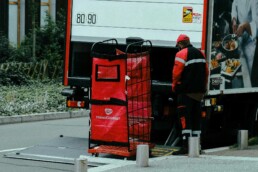
Impact on Fulfillment Services and Logistics
The introduction of taxes on e-commerce delivery fees has far-reaching implications for various sectors, particularly fulfillment services and third-party logistics (3PL) providers. These entities are responsible for the warehousing and distribution of goods, order fulfillment solutions, and inventory management. A new tax could lead to increased operational costs, which may be passed down to consumers.
One of the most affected areas could be last-mile delivery, a critical component of the e-commerce supply chain. Last-mile delivery is often the most expensive and time-consuming part of the delivery process. The introduction of new taxes could further complicate this segment, requiring companies to reassess their pricing strategies and logistics plans. Moreover, the need for order tracking and management becomes even more crucial, as companies strive to maintain transparency with their customers.
Third-party logistics (3PL) providers, in particular, may need to innovate and optimize their operations to mitigate the impact of these new taxes. This could involve exploring cross-docking techniques, enhancing inventory tracking software, or investing in warehouse automation. Companies may also look into freight rate negotiation and freight consolidation to reduce costs. In some cases, the added financial burden may prompt businesses to consider dropshipping solutions as an alternative, allowing them to bypass warehousing altogether.

Looking Ahead
As more states consider the taxation of e-commerce delivery fees, businesses involved in the e-commerce supply chain must stay informed and prepared. The landscape of supply chain management is evolving, and companies need to adapt to new regulations and market conditions. Whether it’s through optimizing order fulfillment metrics and reporting, enhancing inventory forecasting, or exploring new scalable fulfillment solutions, the key to success will be flexibility and innovation.
Beginner’s Guide to Third-Party Logistics (3PL)
The world of e-commerce is always changing, therefore understanding the roll of Third-Party Logistics is integral to keeping up. In light of this our beginner’s guide to third-party logistics (3PL) will delve into the essential aspects, offering insights into fulfillment services, warehousing, and much more.
Read More…
The taxation of e-commerce delivery fees represents a significant shift in how states generate revenue. While it poses challenges for businesses, it also offers an opportunity to contribute to essential public infrastructure projects. Companies must remain agile and proactive, ensuring they can navigate the complexities of this new tax landscape while maintaining efficient and cost-effective operations.
For any questions on how these taxes could impact your business, reach out to Falcon Fulfillment – your partner in navigating e-commerce fulfillment challenges.
Let’s Talk!
How to Seamlessly Switch 3PL Providers
How to Seamlessly Switch 3PL Providers
Switching third-party logistics (3PL), providers can be daunting, but it is sometimes necessary for companies looking to optimize their supply chain. You may have begun to notice your existing provider is unable to meet your growing business needs. This indicates that it might be time to consider an alternative logistics partner. However, switching 3PL providers involves several factors, from cost-effectiveness to service quality, so it is important to take the time to find the right provider for your business. It is necessary to thoroughly investigate your new 3PL partner and confirm the transition to a new partner won’t cause significant business delays. You can ensure a seamless switch to your new 3PL provider by following the steps outlined below.

When is the right time to switch 3PLs?
While there is a truckload of reasons you may decide to switch providers, there are a few common red flags that will indicate it is time to begin switching 3PL providers. They are as follows and in no particular order:
- Consistent mistakes – Mistakes are bound to happen, so the issue is more about the consistency of errors. If your provider gives excellent service 99% of the time with an occasional mistake, that is life. However, if the pattern of incorrect orders, mislabeled addresses, damaged products, missed delivery deadlines, or lost products happens regularly, it’s time to switch.
- Reactive vs. Proactive – The logistics industry changes rapidly, and your provider should consistently improve. A reactive company makes improvements once there is a problem and is slow to adopt new technologies and processes. A proactive logistics provider invests in new strategies and products that streamline fulfillment and improve customer service before they become problematic. If your provider hasn’t improved their infrastructure or customer experience lately, it is likely a reactive organization.
- Old or Segregated Technology – Whether the technology your provider is using is old or simply unable to integrate with your modern sales system, it is time to find a new provider. Having obsolete technology will slow down not only the growth of your business but also the speed at which you can solve fulfillment problems.
- Struggling to Scale – Businesses can often easily handle fulfillment in-house when launching. However, once they hit a pivotal threshold where they need to outsource orders, using a smaller fulfillment company can be tempting. It is crucial to evaluate your growth plans because you can quickly outgrow your 3PLs capacity and have to make another jump. If your existing provider struggles to scale with your growth, it is time to consider alternatives.
Timing Your 3PL Switch
Besides the red flags triggering a switch, selecting a slower season in your sales cycle is equally essential. In other words, you don’t want to attempt to switch 3PL providers during your busiest season. The process to switch providers can take as long as several months and as short as a few weeks. Falcon Fulfillment provides our clients with dedicated account managers and onboarding specialists, so switching 3PL providers is as seamless as possible.
Following these steps ensures your switch to a new 3PL provider goes as smoothly as possible. Researching potential providers, comparing them side-by-side, negotiating your contract, and creating a transition plan will ensure that your switch to a new 3PL provider is seamless and successful.

Following these steps ensures your switch to a new 3PL provider goes as smoothly as possible. Researching potential providers, comparing them side-by-side, negotiating your contract, and creating a transition plan will ensure that your switch to a new 3PL provider is seamless and successful.
Steps to complete before switching 3PL providers
Clarify your business needs
In order to find the best 3PL partner, it is vital to be clear on your current and future business needs. Spend some time evaluating how your existing provider is falling short and what services, communication cadence, scalability, and costs are needed for your success. This is the first step because it will lead your investigation and evaluation of new 3PL providers.
Review your existing contract
Unquestionably, the best time to switch providers without additional hassle is at the end of your contract. However, sometimes the service is subpar so dramatically that it is worth the headache. Regardless, it is important to review the terms of your existing contract as you search for a new 3PL partner. The contract should outline cancellation procedures, fees associated with canceling, and if any current breaches of service would nullify the agreement. Furthermore, reviewing your contract will highlight issues you want to be addressed or remedied with your new fulfillment partner. Be informed and prepared to negotiate a favorable new contract when the time comes.
Interview potential partners
Interviewing potential 3PL partners is crucial to finding the best match because they become an extension of your brand. The best 3PL companies look at their relationships with their clients like business partners rather than clients. When their customers succeed, they succeed and when sales increase, their invoicing increases. When interviewing, there are a few key questions to determine if they are the right fit.
Questions to ask
- How are you different from our existing provider? Have a clear idea of what your expectations are when switching fulfillment companies. In other words, know what you are looking for and be direct in asking if the new fulfillment team has the capabilities to meet your needs. Most fulfillment service providers do the basics of distributing products, but how do they go above and beyond the basics? How flexible are they as you scale up and down seasonally? Do they manage returns and customer service? What is the structure of their pick and pack fees? How clear and transparent is invoicing? These are just a few ideas to get you started.
- How easy is it for your technology to integrate with their platforms? One of the benefits of partnering with a 3PL is using their software. Often you can utilize modern shipping, inventory, and returns management programs without additional investment. That being said, it is crucial to determine if your existing technology is compatible with the systems they currently use. Beware of 3PL companies that say, “Oh, I am sure we will be able to have them integrated.” This is a red flag. If they have never heard of the systems you use or vice versa, running tests before you sign a contract is essential.
- Where are their distribution centers located, and are there expansion plans? One of the greatest benefits of partnering with a solid 3PL is due to leveraging multiple shipping sites. This allows your business to lower shipping costs and improve delivery speeds. Depending on where your primary customer base is or where you plan to launch can determine which 3PL company will best suit your needs.

Review your supply chain.
Once you have interviewed new 3PL providers, it is time to review your supply chain and determine new transit times. Depending on where the new centers are located will impact order and delivery timelines. In addition, make sure to fully understand and follow your new providers receiving protocols to minimize delays or complications. Most customer-focused 3PL providers can assist in reviewing your supply chain and guide you on making further order adjustments.
Slowly begin the transition to the new provider.
While it might be tempting to cut ties with your existing provider and ship all your inventory to the new 3PL immediately, that could be a recipe for disaster. The prudent way to transition is a slow progression whereby you move all new orders to your new provider and continue to fulfill orders through your existing provider until you have adequate stock levels and processes to make the switch. This gradual transition helps to prevent stockouts and backorders.
Keep your customers informed.
No transition is without its complications. This is why it is vital to keep your customers informed of the changes and any new processes they should be aware of, including shipping charges, delivery times, and liquidation of old products. After all, making an order fulfillment change can also allow you to make some product changes as well. Share the good news with your customers not only to keep them informed but to get them excited! Switching 3PL providers will likely give your business more options for your customers, like international shipping or 2-day delivery, etc.
Beginner’s Guide to Third-Party Logistics (3PL)
The world of e-commerce is always changing, therefore understanding the roll of Third-Party Logistics is integral to keeping up. In light of this our beginner’s guide to third-party logistics (3PL) will delve into the essential aspects, offering insights into fulfillment services, warehousing, and much more.
Read More…
Seamlessly switch 3PL providers with Falcon Fulfillment
Falcon Fulfillment specializes in customer-first logistics service. Every one of our clients have a dedicated account manager to help with onboarding, implementation, and ongoing customer support. We offer additional value-added services such as; kitting, returns management service, supply chain management, custom packaging, and more. Our in-house tech teams ensure that software programs can integrate seamlessly and provide a smooth customer experience. Furthermore, Falcon has the industry experience and relationships to provide a personalized experience without losing national level scalability.
Seamlessly switching 3PL providers can be daunting, but it doesn’t have to be disruptive. By carefully reviewing your business needs, interviewing new partners thoroughly, and taking gradual steps, you can transition your order fulfillment to a new partner efficiently and effectively. Learn more about how Falcon Fulfillment can help make your transition effortless, talk to one of our agents today.
If you’re ready to start the transition or have questions, contact us to learn more about our services.
Let’s Talk!
